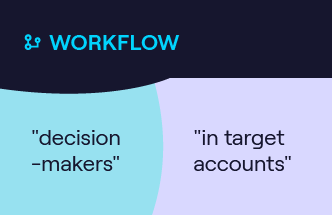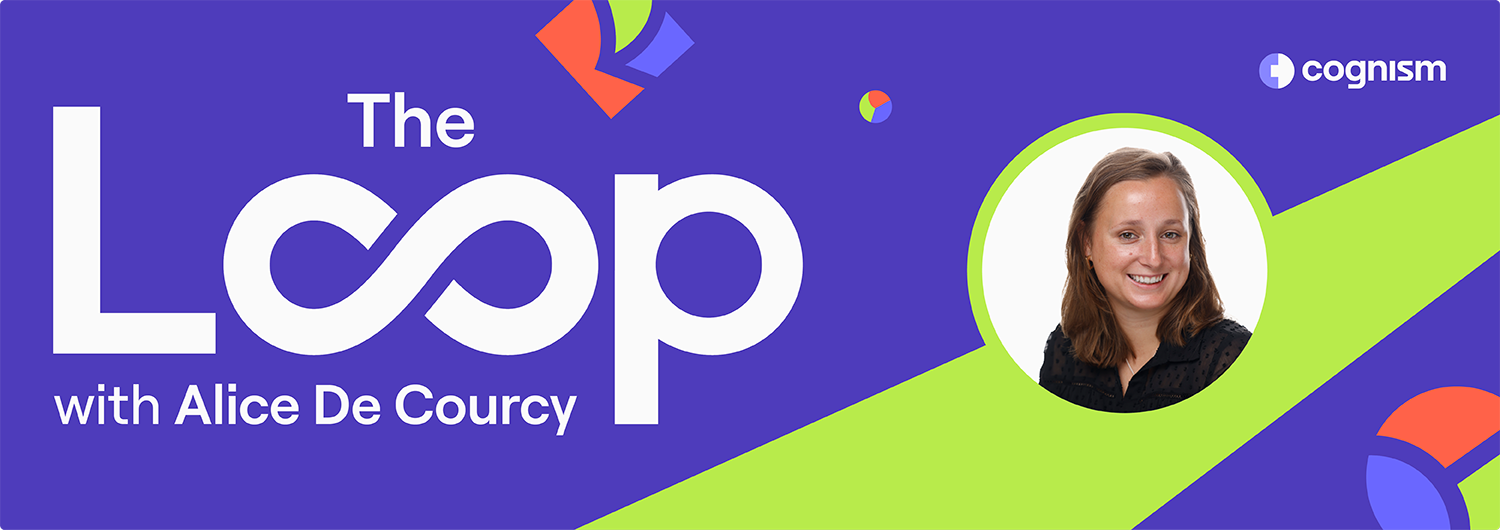
Alice de Courcy spent 3 years building a demand generation playbook that scaled Cognism from $3m to $55m ARR.
Now she shares everything she's learned, tested and experimented with in The Loop 👉
It’s a bi-weekly newsletter read by 3000+ marketers. And the first place she releases her demand gen guides, swipe files and courses (maybe even a sequel to her book, The diary of a first time CMO!)
Get it straight to your inbox.
Sign Me Up
"Don't know where to start with demand gen? The good news is, we're bringing our demand gen learnings from the past 4 years to your inbox - every 2 weeks.
By reimagining traditional marketing approaches with a demand generation lens, you'll quickly adapt to changes in B2B buyer behaviour, which you can leverage in your marketing."
- Alice de Courcy, Group CMO at Cognism and author of The Loop Digest
Curious? Read some sample emails below👇

⏱ 2:30 minute read
💰Conversion metrics to track
💡What to do when conversions are down
But of course, there are levels to this metrics game.
And while pushing top line metrics is the end goal, there’s a lot of other metrics that feed into these. All of which can make a difference to those bigger numbers. Such as:
.png?width=460&height=557&name=1%20(2).png)

We gave him the following dilemma:
Liam, you notice that pipeline is down for the quarter. Looking into things further, you see that conversion rates from inbound demo requests have been slowly dropping. What do you do?
Other than having heart palpitations! Liam explains where he would start:
“If conversion rates were dropping I would instantly check two things:”
- The quality of MQLs
- And the sales follow up
“If I’m looking at quality, then I’m looking at the number of MQLs (by MQLs in this instance, we are referring to inbound demo requests) and where they are coming from, whether it’s Google Organic, Google Paid, LinkedIn or another social channel.”
“I’m checking this to see if there are any places where we’re clearly targeting the wrong people who might be inflating the MQL number and targeting the wrong intent.”
Idea is to catch any places where we might be setting the wrong expectations for what Cognism does or what we offer.
Meaning we can correct any issues of bringing the wrong kinds of people inbound who end up dropping out the bucket when they realise there isn’t a fit. Instead, refining our ads and content to bring in the right fit accounts.
He adds:
“Say I found a certain campaign that was creating lots of leads but they weren’t converting, I’d then look to turn that off or reduce spend on it.”
Then Liam would tackle the sales follow up:
- Are the leads we send through being actioned by our sales team
- Are any going missing?
- Are sales at capacity?
- Is the booking and routing technology working correctly and fast enough?
- Are sales trained enough to book meetings as regularly as possible?
“If it appears to be a sales problem, rather than a lead quality issue, I would first test the routing and inbound flow and process. Either asking an external person to test the system or testing it myself.”
“I’d then look at trends in inbounds vs sales capacity to see if it was a capacity issue and we in fact need more reps. Getting direct feedback from the sales team on the leads and process too.”
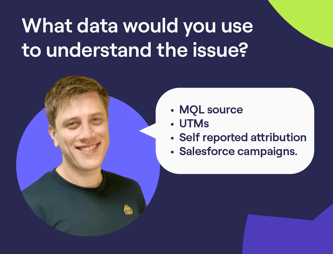
So with all this in mind, what might be the action plan?
Liam shares his ideas for creative solutions:
“Off the top of my head, here are a few ideas I might explore to tackle an issue like this:”
- Automations - can we automate any part of the follow up to make it more direct, simple, buyer-centric and free from human error?
- Optimising for intent - are all our demand capture programs focused exclusively on intent?
- Updating our system - can we have a grading system to ensure we’re capturing the right customers that convert and how can we increase that percentage
“Once I have a plan in mind, I’d share a step-by-step of the actions planned or taken with senior leadership in real time. After solidifying our next steps, I’d create a deck or detailed email to run through with the rest of the team.”
And lastly, Liam adds:
“Also I’d likely help out with any forecasting of downward impact resulting from the poor conversion rates and when we can start to see improvement.”
And there you have it, Liam’s action plan!
Keep your eyes peeled for next week when we delve even further into engagement metrics...
Stay 'looped in' on how to reach modern B2B buyers
🎧 POD: ABM 101 - Run successful ABM plays
W/ Laura Lister, Head of ABM, Advanced.
📹 VIDEO: 6 steps to run a data driven campaign
Run a campaign informed by the numbers.
📰 10 marketing metrics to improve
A guide to metrics you need to be tracking.
Until next time! 👋
Alice de Courcy

⏱ 1:00 minute read
👍 3 rules for long form content
📝 Free distribution checklist
In these recent newsletters, we’ve been covering some of our updated tactics when it comes to eBooks and long form content.
But this next part is relevant for all of your value-led content.
Whether you’re planning on gating your content or not - but especially if you are - the content has to live up to, or exceed your prospects’ expectations.
Liam, our VP of Marketing said:
“You can’t just be repurposing SEO blogs as eBooks, if you’re gating content - and realistically even if you’re not - it becomes all about quality. You want someone to think ‘oh, I really want to see this’.”
So here are some rules we have set ourselves to benchmark our long form content against:
#1 It must either help inform our ICP about something they wish to learn, or help them solve a real problem they’re facing.
- Would they find the subject interesting? Enough to take time out of their busy work day to read?
- Is this based on research you’ve done or grounded by evidence from your ICP? For example, customer/ICP interviews or surveys.
- Don’t force content just because it aligns with your product. The primary goal is to engage and educate. Become a recognisable, credible source of information. The secondary goal would be a dotted line into your product.
#2 It must be accurate and should include subject matter experts
- Have you worked with experts who can add credibility to the information?
- Could you have the content proofread by an expert who can sign off on it?
#3 It must be unique
- While desk research can compliment your eBook, if it’s just a compilation of information that can be found online, it’s not going to make for an impressive asset.
- Could you find it elsewhere online with a few Google searches?
In addition to this - you should look for ways to bump up the perceived value of your long form content.
Like adding in some extras, such as:
- Exclusive SME content - voice notes, tutorials, explainer videos.
- Templates - for example, how to calculate your x, y and z. Or a checklist for a, b and c.
- Exclusive podcast episodes
- Swipe files
For example, in our recent eBook release, ‘The Ultimate eBook about producing eBooks’, we gave away this added resource (ungated!!)
The distribution checklist.
Because:
- It helps make the lives of our readers wanting to follow our advice easier, by providing a template and ideas for distribution.
- It adds to the perceived value of the content - as an added extra that you’d only get to see if you consumed the content.
This, alongside the SME packed expert insights within eBook content = ✨ value-led content ✨ which we delivered in an interactive format with a bunch of easy to consume videos.
Stay 'looped in' on how to reach modern B2B buyers
📰 Ultimate ebook... on producing ebooks
24 stealable ideas to build long form assets.
🎧 POD: Getting inter-departmental alignment
W/ Andrei Zinkevich, Co-founder @Full Funnel.io
📰 A guide to memorable, emotional marketing.
Frameworks, examples and measurement tips inside.
Until next time! 👋
Alice de Courcy

⏱ 1:10 minute read
❓ The Salesforce awareness problem
🎁 'Unboring' B2B marketing gallery
We hope you had a great time celebrating and are looking forward to what ‘24 has to offer.
To mark the occasion, we thought we’d share one of our new year's resolutions with you.
‘We will make a conscious effort to make being memorable a priority in our marketing activity in 2024.’
And there’s good reason behind this being a primary focus.
Marketing can go a long way in driving the growth of a product or brand - but this whole process only works if the marketing activity is memorable.
In other words, you can invest loads into marketing campaigns - but if your intended audience can’t remember you when they’re ready to buy… well, then it’s all a bit of a waste.
Only marketing can reach buyers early enough in the process to start building trust, credibility and relevant associations in their minds.
So that when buyers do come in-market, they remember your brand first.
.png?width=500&height=250&name=1%20(4).png)
However, being remembered is only half the battle. You need to be remembered and associated with the right things.
For example, Salesforce did some research and discovered they had an awareness problem.
The issue wasn’t that people weren’t aware that Salesforce existed - the problem was that their target market didn’t really know what they sold.
So they had to put together this brand campaign that built memories - attached to associations that they wanted people to have about their brand.
The good news is - buyers are looking for shortcuts. They want it to be easy to find a solution.
In complex buying situations - buyers have a lot of options and they want anything that will make that decision-making process faster and easier.
So if you’re easy to recall when a buyer realises they have an issue - without them having to go to Google to search for related terms - it’s such a massive advantage.
AKA - If you’re already front of mind with a buyer, and associated with solving specific problems, your in-market campaigns will make much more of an impact. Because they already recognise your brand and what you sell.
If you’re interested in learning a little more about how we’re doing this at Cognism, then stick around. Our next newsletter will break down three ways in which we are making our marketing memorable in the coming year.
Stay 'looped in' on how to reach modern B2B buyers
📰 Full guide to memorable B2B marketing
Frameworks, examples and measurement tips inside.
🎧 POD: Creating memorable, emotional marketing
W/ Drew Spencer Leahy, @Hockeystack
💡 'Unboring' B2B marketing gallery
Swipe campaign ideas from Gong, Trainual and more
Until next time! 👋
Alice de Courcy

⏱ 90 second read
🎥 VIDEO: How Cognism measures marketing
One thing that we’re often told as marketers is that you can’t measure brand activity.
And yes, measuring brand activity is hard. It’s always been hard and likely always will be.
But the truth is you can’t measure anything 100% precisely.
All you can do is measure what you can and gain better insight for decision making. And there’s a variety of ways to do this for brand marketing.
1) Surveys
Start with market research surveys.
If you have, say, five associations you want people to hold with your brand, and you want to find out how you measure up to them right now. Go out and find a baseline.
Ask your customers and your prospective buyers’ questions about:
- What they think you sell.
- What words they’d use to describe your business.
- What reasons they think someone might buy from you.
- What content or adverts they’ve seen from you that they recall.
- Use this to help you build a brand campaign to improve any areas that are lacking.
And then ask them again in 6, 9 or 12 months to see if you discover any improvements.
2) Baseline sales growth
There should be a growth in sales and revenue that comes to you organically because the brand marketing process is working.
They needed your product and they came in-market, remembered you and came directly to you.
Now, this might sound easy to measure, but it isn’t that simple. Because there are many reasons that people might come inbound to you. For example, your SEO team is working effectively.
But if, over time, you see that baseline revenue growing steadily, it’s a good indication that the brand activity you did last year and the year before is paying off.
3) Branded search
Another way to get an indication of whether your brand efforts are working is through tracking your branded search.
How many people are searching for your company name on search engines?
Because realistically, they only Google your name if they remember your brand exists and are trying to visit your website.
To take this a step further, you could look at your share of search - comparing how many branded searches you have compared to your competitors.
And whether that baseline share of search is growing over time.
4) Engagement
Engagement is no longer a vanity metric - instead, engagement is a super-important way to tell if your audience knows and likes your brand.
- Have you got growth in your follower count?
- A growth in engagement rates?
- Are people following you in multiple places?
5) Self-reported attribution
You know those ‘how did you hear about us?’ questions?
They can be incredibly insightful when it comes to finding out what content or ads prospects remember.
They might have discovered you through your podcast, LinkedIn channel or somewhere else.
Meaning you can double down on the memorable channels that work best.
----------
Brand marketing can take a lot of time to see results, but those continued brand activities compound over time.
The brand efforts you make today will result in increased inbound requests next year. And the next year. And the next!
Stay 'looped in' on how to reach modern B2B buyers
🎥 VIDEO: How Cognism measures marketing performance
5 minute watch at 1.5x speed. Our full system explained.
🎧 POD: Measuring marketing activity
W/ Ben Dutter, Chief Strategy Officer @ Power Digital.
📰 10 B2B marketing metrics to measure and improve
What gets measured, gets managed.
Until next time! 👋
Alice de Courcy
Here's what our subscribers think 👇
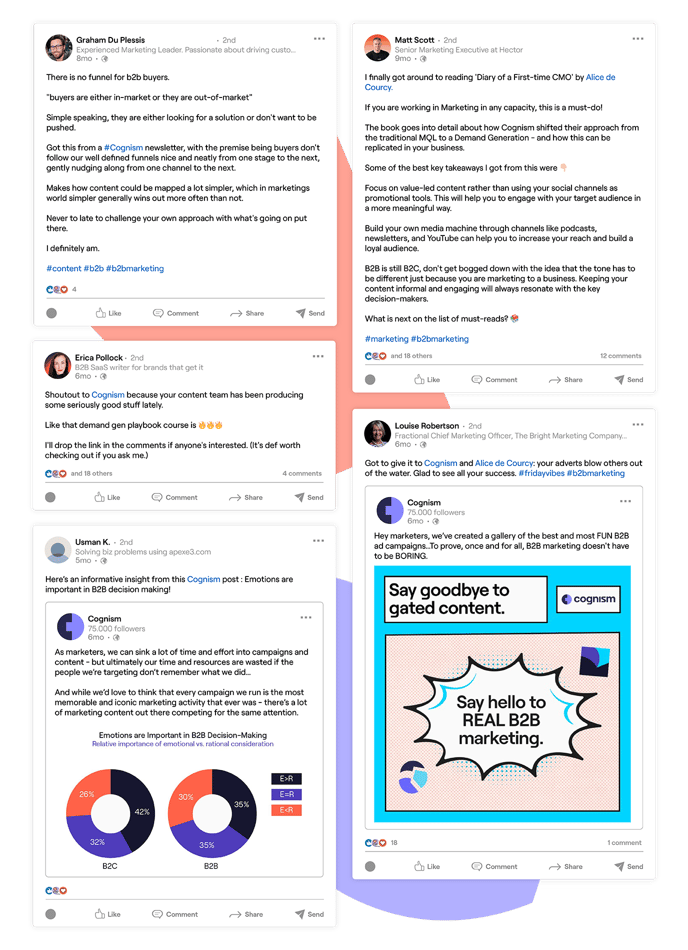

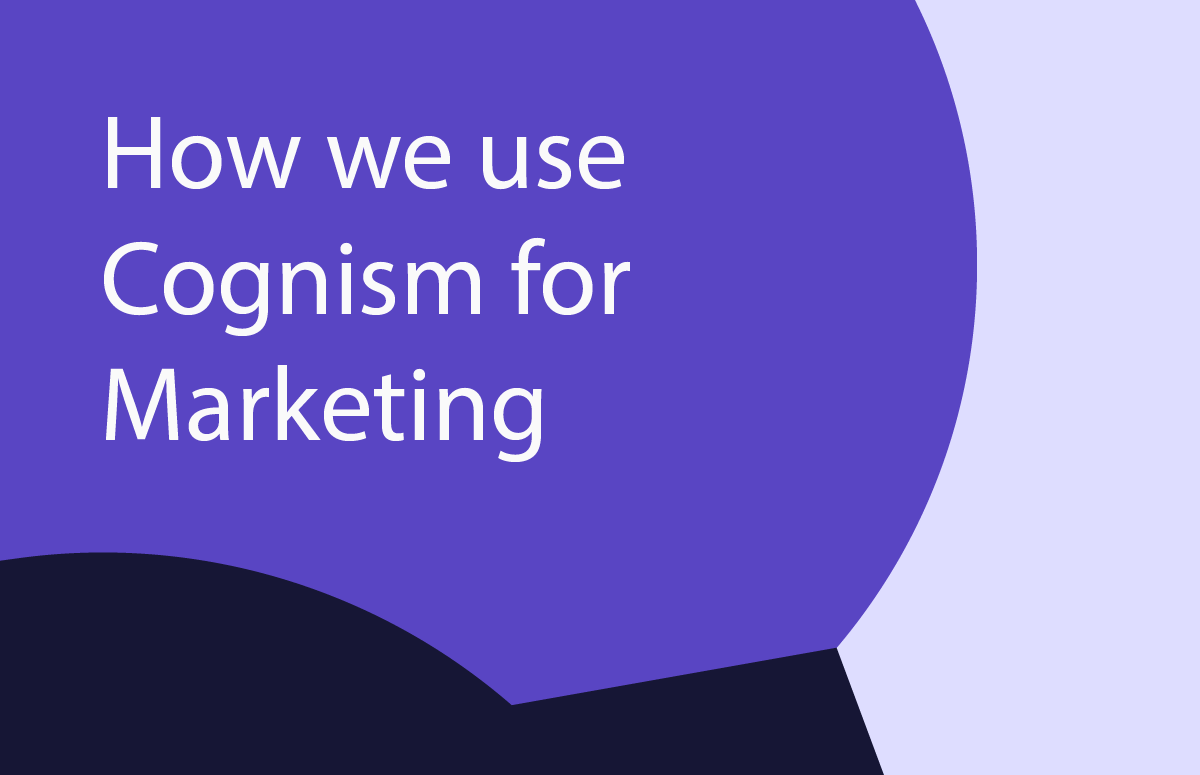
.png)
